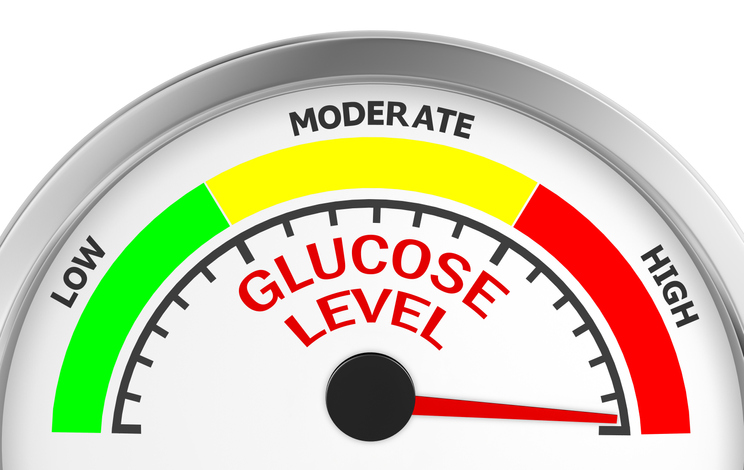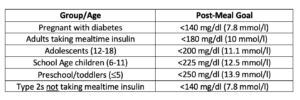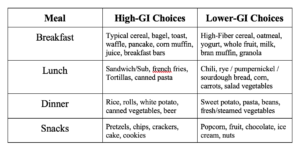what happens to blood glucose level after the person eats?

Good news! The diabetes world no longer revolves around the A1c. Time-in-range and glucose variability play a much greater role. We also know more than always about the harmful furnishings of after-meal blood sugar spikes.
What's a Blood Sugar Fasten? And Why Practise They Happen?
Postprandial spikes are temporary loftier blood sugars that occur soon later eating. It is normal for the blood sugar to rise a small corporeality later eating, even in people who do non have diabetes. Notwithstanding, if the spike is likewise loftier, it can bear upon your quality of life today and contribute to serious health bug downward the road.
The reason blood sugar "spikes" is a unproblematic affair of timing. In a not-diabetic, consumption of carbohydrate results in two important reactions: the immediate release of insulin into the bloodstream, and product of a hormone called amylin which keeps food from reaching the intestines too apace. In most cases, the after-meal claret sugar rise is barely noticeable.
Even so, in people with diabetes, the state of affairs is similar a baseball player with very slow reflexes batting against a bullpen who throws 98 mph fastballs: the timing is not good. Rapid-acting insulin that is injected (or infused by a pump) at mealtimes takes approximately 15 minutes to outset working, 60-90 minutes to "peak," and iv hours or more to stop working. And don't forget most the amylin hormone effect. In people with diabetes, amylin is either produced in insufficient amounts or not at all. As a upshot, food digests even faster than usual. The combination of slower insulin and faster food tin can cause claret sugar to rise absurdly high shortly afterwards eating. This is followed by a sharp drop one time the mealtime insulin finally kicks in.
Why Are Claret Sugar Spikes a Problem?
Even though the fasten is temporary, all of those spikes throughout the mean solar day tin raise your HbA1c. Research has shown that for those with an A1c beneath 7.5%, mail-meal readings really take a greater influence on A1c than fasting blood sugars. In other words, managing pre-meal readings volition only get y'all so far. If yous desire tight control, you need to pay attention to the after-meal glucose besides.
The long-term effects of postprandial hyperglycemia have been studied extensively. For those with type 1 diabetes, meaning mail-meal rises have been shown to produce earlier onset of kidney affliction and accelerate the progression of existing eye problems (retinopathy). And like a dagger through the heart, postal service-meal hyperglycemia is an independent risk factor for cardiovascular problems. Recently, post-meal spikes and glucose variability have been associated with macerated encephalon function and an increased risk of dementia.
But the problems are non limited to long-term health issues. Any time blood sugars rise especially high, even temporarily, our quality of life suffers. Energy decreases, cognitive (thinking) ability falters, physical/athletic abilities become diminished, and moods become altered. And don't forget: What goes upwardly must come downward. The rapid blood sugar refuse that usually follows a post-meal spike tin cause faux hypoglycemic symptoms.
Claret Sugar Measurement & Goals
The exact timing of blood sugar spikes can vary from person to person and repast to meal. Notwithstanding, on boilerplate, the postal service-meal peaks tend to be about one hour and 15 minutes after starting a repast. Merely the best style to measure post-meal patterns is by using a continuous glucose monitor (CGM). These systems, bachelor from Medtronic, Dexcom, Abbott and Senseonics, provide glucose readings every couple of minutes and then you won't miss the elevation, whenever it happens to occur.
So exactly how high is TOO High? There is no universal answer. The American Diabetes Clan recommends keeping blood carbohydrate beneath 180 mg/dl 1-2 hours after eating. However, no specific guidelines are provided for type-1 vs. type-2 diabetes, insulin users vs. not-insulin users, or children vs. adults.
Based on my experience, I usually recommend the post-obit:

Post-meal readings that are consistently in a higher place these levels should be addressed by y'all and your healthcare team (see strategies in the sections below).
How to Control a Blood Sugar Spike
To reduce the spike, a number of strategies can be used. Some involve medications while others involve our lifestyle choices. Here are a few medical approaches:
1. Choose the Right Insulin
The correct insulin can make or break your power to command those subsequently-meal spikes. In general, insulin that works speedily and for a short menses of time will work improve than those that piece of work slowly over a long menstruation of time.
For instance, rapid-acting insulin analogs (Humalog, Novolog or Apidra) will cover the mail service-meal blood sugar rising much ameliorate than regular insulin. Newer ultra-rapid insulins, such every bit Fiasp, piece of work even faster.
The way insulin is administered can dramatically affect its speed of action. Afrezza is an inhaled insulin that can be used at mealtimes. Considering the dry powder is absorbed through the lungs, its onset and peak are much earlier than injected insulin. For those who don't mind a twinge of pain, injecting insulin into muscle will also brand it blot and act much quicker than injecting it into the fat layer below the pare.
Research has as well shown that injected insulin tin can work much faster when the injection site is warmed past rubbing the site, immersing in warm water, or exercising the musculus well-nigh the site. Warming the site causes the claret vessels near the skin to dilate, which allows the insulin to absorb more than quickly. Past the fashion, smoking causes the blood vessels to constrict, and so quitting smoking might improve your post-meal claret sugar (in add-on to helping y'all and those effectually you to live longer).
ii. Dorsum Up Your Bolus
For those taking rapid-acting insulin at mealtimes, the timing of the injection (also chosen a "bolus") tin can have a huge impact on the afterwards-meal spikes. Unless you lot suffer from gastroparesis, it is best to give boluses before eating. How long before? It depends. The college your blood sugar, the earlier the bolus should be given. With a pre-repast blood sugar that is well above-target, it is best to give the bolus and and then wait thirty minutes before eating. Near your target claret carbohydrate? Wait 15 minutes. Below target? Have the bolus and consume right away. Research has shown that merely giving mealtime boluses before eating rather than after can reduce the post-meal spike by an average of 45 mg/dl.
iii. Bolus for the Basal
In order to have more insulin working right after eating and less working several hours later, a pump user can run a substantial temporary basal reduction for three hours just before eating and give a normal bolus equal to the basal insulin that would have been delivered. John Walsh, coauthor of the Pumping Insulin books, calls this a "Super Bolus". For instance, if your basal charge per unit in the morning is .6 units per hour, you could bolus an extra one.eight units earlier breakfast and then set a temp basal of 10% (90% reduction), for the next 3 hours.
4. Choose the Right Medication
Two classes of injectable hormones, GLP-1 receptor agonists and amylin mimetics, accept powerful effects on mail-meal blood carbohydrate. Both GLP-1s and Symlin dull gastric emptying and keep carbohydrates from raising the blood sugar too speedily after meals. Symlin, which is a replacement for the amylin hormone (which is lacking in people with diabetes), also helps to diminish appetite and edgeless post-meal glucagon secretion. GLP-1s blunts appetite and promote the growth of insulin-producing cells in the pancreas of those with type-2. And then both can contribute to improve mail service-meal claret sugar control.
For type-2s, the pick of oral medication can also impact your after-meal control. Sulfonylureas stimulate the pancreas to secrete extra insulin throughout the day, without regard to meal timing. There are alternative medications called meglitinides which likewise stimulate the pancreas but do and so in a much faster and shorter manner. When taken at mealtimes, meglitinides produce better after-meal command than sulfonylureas.
Lifestyle Approaches to Stop Blood Saccharide Spikes
one. Recall Lower GI
Glycemic Index (GI) refers to the speed with which food raises the claret saccharide level. While all carbohydrates (except for cobweb) catechumen into blood carbohydrate somewhen, some practise so much faster than others.
Many starchy foods (breads, cereals, potatoes, rice) have a high GI; they digest easily and convert into claret carbohydrate chop-chop. Some starchy foods (pasta, beans, peas) have lower GI values. Foods that have dextrose in them tend to have a very high GI. Table sugar (sucrose) and fructose (fruit carbohydrate) take moderate GI values, while lactose (milk sugar) is slower to enhance blood sugar. A number of books, such as Dr. Jennie Brand-Miller's Glucose Revolution series, contain extensive information about the glycemic index, along with lists of GI values for hundreds of foods.
As a general rule, switching to lower-GI foods volition help to reduce your subsequently-meal blood carbohydrate spikes.
Below are some examples of ways to substitute typical high-GI foods for lower-GI options:

Another unique food property that affects rate of digestion is acidity. This is why sourdough bread has a much lower GI value than regular staff of life. Research has shown that adding acerbity in the grade of vinegar (directly or in dressing/additive form) can reduce the 1-hour mail service-meal claret sugar rise by 50% or more.
2. Divide Your Repast
When having a full meal or large snack, consider saving a portion for one or ii hours later. Nonetheless give the full mealtime insulin before eating any of the meal; just don't eat all of the food at once. For example, if you have a bowl of cereal and juice for breakfast, considering having the cereal at breakfast time, and postpone the juice until mid-morning.
iii. Get Moving
Concrete activity afterward eating tin can reduce post-meal spikes by diverting blood flow away from the intestines, resulting in slower absorption of sugars into the bloodstream. Plus, the sugar that does enter the bloodstream is likely to be "consumed" by the working muscles. It doesn't take much activity: Ten or 15 minutes (or more) of mild activity will ordinarily get the job done. The key is to avoid sitting for extended periods of time after eating.
4. Prevent Hypoglycemia
Low claret sugar is problematic in many ways. 1 of the body'southward typical responses to hypoglycemia is accelerated gastric emptying: nutrient digests and raises claret saccharide even more apace than usual. Prevention of hypoglycemia prior to meals and snacks is withal another effective strategy for controlling mail-meal blood sugars.
Gary Scheiner MS, CDE is Owner and Clinical Managing director of Integrated Diabetes Services, a private practise specializing in intensive insulin therapy. He is author of several books, including Think Like A Pancreas: A Practical Guide to Managing Diabetes With Insulin, and was named 2014 Diabetes Educator of the Year past the American Association of Diabetes Educators. Gary has had Blazon-1 diabetes for 34 years. He and his team of Certified Diabetes Educators consult with people throughout the world via phone and the internet. He can be reached at gary@integrateddiabetes.com, or +1 610-642-6055.
Source: https://tcoyd.org/2019/10/strike-the-spike-controlling-blood-sugars-after-eating/
0 Response to "what happens to blood glucose level after the person eats?"
Post a Comment